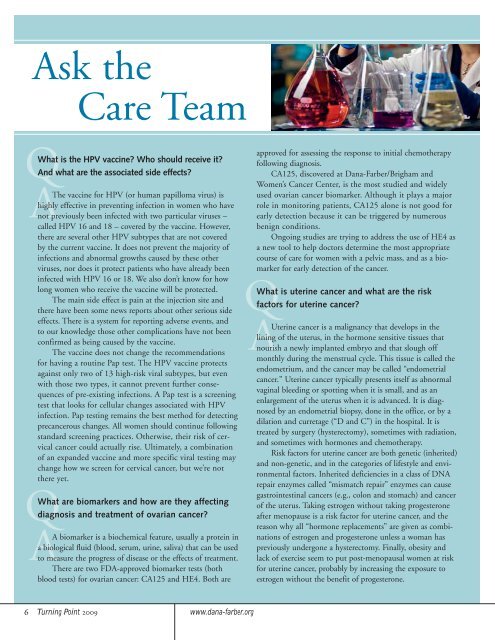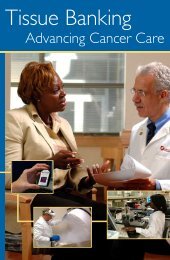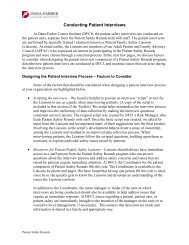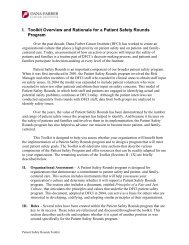Turning Point - Dana-Farber Cancer Institute
Turning Point - Dana-Farber Cancer Institute
Turning Point - Dana-Farber Cancer Institute
You also want an ePaper? Increase the reach of your titles
YUMPU automatically turns print PDFs into web optimized ePapers that Google loves.
Ask the<br />
Care Team<br />
What is the HPV vaccine? Who should receive it?<br />
And what are the associated side effects?<br />
The vaccine for HPV (or human papilloma virus) is<br />
highly effective in preventing infection in women who have<br />
not previously been infected with two particular viruses –<br />
called HPV 16 and 18 – covered by the vaccine. However,<br />
there are several other HPV subtypes that are not covered<br />
by the current vaccine. It does not prevent the majority of<br />
infections and abnormal growths caused by these other<br />
viruses, nor does it protect patients who have already been<br />
infected with HPV 16 or 18. We also don’t know for how<br />
long women who receive the vaccine will be protected.<br />
The main side effect is pain at the injection site and<br />
there have been some news reports about other serious side<br />
effects. There is a system for reporting adverse events, and<br />
to our knowledge those other complications have not been<br />
confirmed as being caused by the vaccine.<br />
The vaccine does not change the recommendations<br />
for having a routine Pap test. The HPV vaccine protects<br />
against only two of 13 high-risk viral subtypes, but even<br />
with those two types, it cannot prevent further consequences<br />
of pre-existing infections. A Pap test is a screening<br />
test that looks for cellular changes associated with HPV<br />
infection. Pap testing remains the best method for detecting<br />
precancerous changes. All women should continue following<br />
standard screening practices. Otherwise, their risk of cervical<br />
cancer could actually rise. Ultimately, a combination<br />
of an expanded vaccine and more specific viral testing may<br />
change how we screen for cervical cancer, but we’re not<br />
there yet.<br />
What are biomarkers and how are they affecting<br />
diagnosis and treatment of ovarian cancer?<br />
A biomarker is a biochemical feature, usually a protein in<br />
a biological fluid (blood, serum, urine, saliva) that can be used<br />
to measure the progress of disease or the effects of treatment.<br />
There are two FDA-approved biomarker tests (both<br />
blood tests) for ovarian cancer: CA125 and HE4. Both are<br />
approved for assessing the response to initial chemotherapy<br />
following diagnosis.<br />
CA125, discovered at <strong>Dana</strong>-<strong>Farber</strong>/Brigham and<br />
Women’s <strong>Cancer</strong> Center, is the most studied and widely<br />
used ovarian cancer biomarker. Although it plays a major<br />
role in monitoring patients, CA125 alone is not good for<br />
early detection because it can be triggered by numerous<br />
benign conditions.<br />
Ongoing studies are trying to address the use of HE4 as<br />
a new tool to help doctors determine the most appropriate<br />
course of care for women with a pelvic mass, and as a biomarker<br />
for early detection of the cancer.<br />
What is uterine cancer and what are the risk<br />
factors for uterine cancer?<br />
Uterine cancer is a malignancy that develops in the<br />
lining of the uterus, in the hormone sensitive tissues that<br />
nourish a newly implanted embryo and that slough off<br />
monthly during the menstrual cycle. This tissue is called the<br />
endometrium, and the cancer may be called “endometrial<br />
cancer.” Uterine cancer typically presents itself as abnormal<br />
vaginal bleeding or spotting when it is small, and as an<br />
enlargement of the uterus when it is advanced. It is diagnosed<br />
by an endometrial biopsy, done in the office, or by a<br />
dilation and curretage (“D and C”) in the hospital. It is<br />
treated by surgery (hysterectomy), sometimes with radiation,<br />
and sometimes with hormones and chemotherapy.<br />
Risk factors for uterine cancer are both genetic (inherited)<br />
and non-genetic, and in the categories of lifestyle and environmental<br />
factors. Inherited deficiencies in a class of DNA<br />
repair enzymes called “mismatch repair” enzymes can cause<br />
gastrointestinal cancers (e.g., colon and stomach) and cancer<br />
of the uterus. Taking estrogen without taking progesterone<br />
after menopause is a risk factor for uterine cancer, and the<br />
reason why all “hormone replacements” are given as combinations<br />
of estrogen and progesterone unless a woman has<br />
previously undergone a hysterectomy. Finally, obesity and<br />
lack of exercise seem to put post-menopausal women at risk<br />
for uterine cancer, probably by increasing the exposure to<br />
estrogen without the benefit of progesterone.<br />
6<br />
<strong>Turning</strong> <strong>Point</strong> 2009<br />
www.dana-farber.org

















